Bradford Tramways Company
(Bradford Tramways and Omnibus Company)
History
The Bradford Tramways Company was formed in 1881 expressly to operate the newly constructed 4 ft-gauge tramways of Bradford Corporation, being restructured as a limited company — the Bradford Tramways and Omnibus Company Limited — on the 4th February 1882, just two days after operation had commenced. Two of the men behind the BTCo were the well-known tramway entrepreneurs Daniel Busby and William Turton, both of whom had interests in several tramways in the north of England, most notably, those of Manchester, Leeds, Liverpool and Salford.
Bradford Corporation was keen to retain control of any tramway development within the town, obtaining powers to build its first tranche of lines in 1881. Although it was permitted to build tramways, the Tramways Act of 1870 forbade local authorities from operating them, except in the unlikely event that a lessee could not be found, as was later to be the case at nearby Huddersfield. Operation of the new lines was therefore formally leased to the BTCo for 21 years, construction commencing on the 8th September 1881, with the first line — along Manningham Lane — opening on the 2nd February 1882. The two remaining lines, which ran along Leeds Rd and Sunbridge Rd, opened on the 7th June and the 25 September, respectively. All these lines initially used horse traction, though on the latter two, it was soon replaced by steam traction, Leeds Rd steam services commencing on the 2nd August 1882 and Sunbridge Rd on the 27th September 1882, just two days after it had been opened using horse traction.
Further powers were obtained in 1883, which included a line along Manchester Rd to Bankfoot. The corporation naturally assumed that the BT&OCo would take on the lease, but instead it declined, being either unwilling or unable to take on the lease. This was a decision that the company certainly came to regret, as the new line, which opened on the 8th September 1884, turned out to be an extremely profitable one for the new lessee, the Bradford and Shelf Tramways Company. The failure to agree terms for this lease seems however not to have impacted relations between the company and the corporation, as subsequent new lines — built under powers granted in 1883, 1886, 1887 and 1890 — were leased to the company. These included: an extension of the Manningham Lane line to Frizinghall (opened on the 26th January 1885); new lines to Allerton (opened on the 19th November 1887), Undercliffe (opened on the 10th October 1888) and Tong (opened in sections between the 6th April 1893 and the 2nd March 1894); and an extension of the Leeds Rd line to Thornbury (opened in October 1888). With the exception of the Manningham Lane extension, all these new lines were operated by steam traction.
On the 31st March 1893, the company also took over operation of Shipley Local Board's tramway from the Bradford boundary at Frizinghall to Saltaire, again using steam traction. This had previously been operated as a horse tramway by the defunct Bradford and District Tramways Company Ltd, but had been closed since the 9th October 1891. Although steam services to Saltaire ran along Manningham Lane, services to Lister Park Gates (North Park Rd), which also used the lane, continued to use horse traction.
At its maximum, the BT&OCo worked circa 14 miles of tramway, 1.4 miles leased from Shipley Local Board (Shipley Urban District Council from 1894) and the rest from Bradford Corporation. The lines radiated out from Forster Square and Town Hall Square: northeastwards to Undercliffe; eastwards along Leeds Rd to Thornbury; westwards along Sunbridge Rd to Four Lane Ends and Allerton; and northwards along Manningham Lane to Lister Park Gates, Frizinghall and Saltaire.
Although the company's leases did not expire until 1903, the writing was clearly on the wall well before this, the corporation opening the first line of its ambitious new electric tramway system on the 30th July 1898. The new electric tramway was known as Bradford City Tramways, the town having been granted city status on the 9th June 1897. Once the new electric lines had been built, the corporation's attention inevitably turned towards the existing horse and steam-operated lines, which it could allow the lessees to keep running until 1903, or terminate them earlier, but paying compensation. The corporation's desire to press on with its grand scheme, and thereby realise the benefits of a fully integrated system sooner rather than later, led it to terminate both the BT&OCo's and the B&STCo's leases on the 31st January 1902. The corporation duly took over operation of all the horse and steam lines the following day, using engines and trailers leased from the companies, all the operating staff having become employees of the corporation.
Conversion to electric traction proceeded apace, the Thornbury route switching over to electric operation barely four weeks later on the 27th February 1902. The last horse car service is believed to have run on the 16th May 1902, with the last steam service over lines formerly worked by the BT&OCo running on the 5th June 1902. This was however not the last BCT-operated steam tram service of all, as services over the line to Shelf, formerly worked by the B&STCo, ran until the 1st April 1903.
The BT&OCo proved to have been a very worthwhile investment, paying its rent to the two local authorities, building up a sizeable contingency fund, and consistently paying high dividends. After two decades of dividends, shareholders even got back their original investment plus 30%.
Uniforms
Photographs of the Bradford Tramways and Omnibus Company, as well as its earlier incarnation, the Bradford Tramways Company, are relatively numerous, though counter-intuitively, the later years of operation are poorly represented. In common with the majority of horse-drawn tramways in the British Isles, drivers wore a variety of informal attire, usually reasonably heavy duty, along with the fashionable headgear of the day, predominantly the bowler hat, and later on, the flat cap. Likewise, and in common with many other steam-operated services throughout the country, engine drivers wore very similar attire to their railway counterparts, namely, heavy cotton trousers and jackets, often light in colour, along with cloth or soft-top caps. The caps do not appear to have borne badges of any kind.
The earliest photos show conductors wearing a variety of jackets, suggesting that they were self purchased. The cap however, was almost certainly company issued, and took the form of a tall kepi (often referred to as a 'pill box') bearing a large metal cap badge. No examples of these badges are known to have survived, so all that can be stated is that they were oblong in form, with a small semi-circular protrusion at the top, a form/shape that was used by several other steam tramway operators, and which was very reminiscent of American practice. The badge presumably bore the name of the company (or initials), as well as the bearer's grade, i.e., 'Conductor'. A photo has also survived which was very probably taken in the last year or even the last months of operation; this clearly shows a conductor wearing a kepi bearing a large semicircular cap badge — CONDUCTOR — but almost certainly of embroidered cloth rather than metal. This suggests that the metal cap badges were superseded at some point. The odd photo has also survived of conductors wearing bowler hats, though whether this indicates that the caps fell out of use at some point is difficult to say.
At some point, possibly in the early-to-mid 1890s, the company may have begun to issue its conductors with double-breasted jackets with two rows of four buttons and lapels, though the evidence for this is hardly conclusive. It is unclear whether these jackets carried any insignia.
Inspectors were issued with single-breasted jackets with lapels, and possibly waistcoats too. Headgear took the form of a smart kepi with a glossy peak; in one photograph (see below) a small round cap badge is evident, whereas in the other surviving photograph, this is absent.
Further reading
For a history of Bradford's tramways, see: 'Bradford Corporation Tramways' by J S King; Venture Publications (1999). A more detailed account of Bradford's steam trams can be found in 'A History of the British Steam Tram - Volumes 2' by David Gladwin; Adam Gordon Publishing (2006).
Images
Horse tram drivers and conductors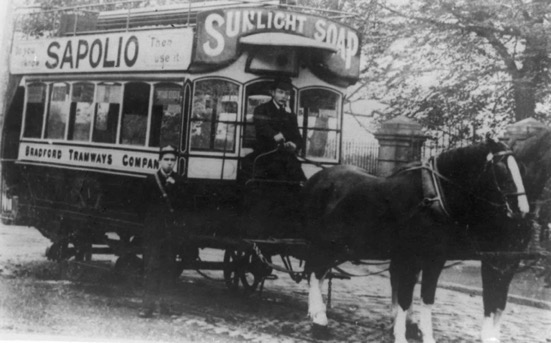
A conductor and driver pose with Horsecar No 1, on an Eade's Patent reversible truck, at the terminus at Lister Park Gates — photo dated 1882. Photo courtesy of the National Tramway Museum.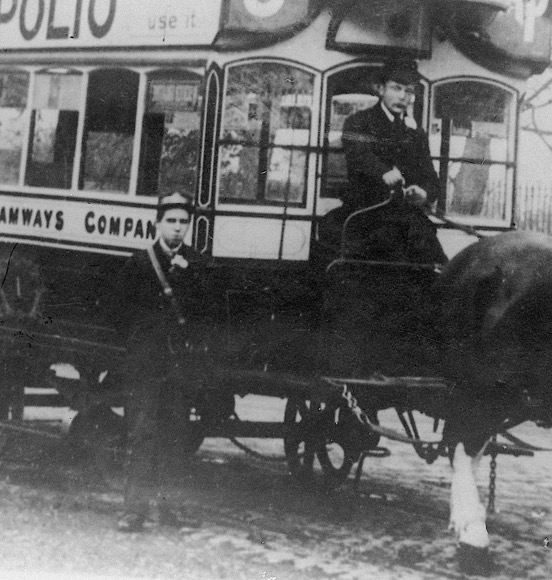
A blow-up of the above photo showing the conductor and the driver. The latter is wearing informal attire with a bowler hat, whilst the former is clearly wearing a kepi-style cap that bears a large metal cap badge. The form of this cap badge is very reminiscent of American railroad and street car systems.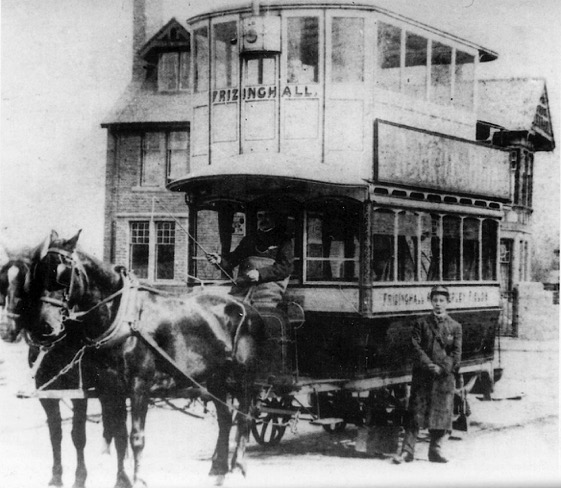
A driver (wrapped in a blanket) and a conductor with Horsecar No 6 at Frizinghall in 1886. The conductor is wearing a long greatcoat, probably self purchased. Photo courtesy of the Tramways and Light Railway Society, with thanks to David Voice.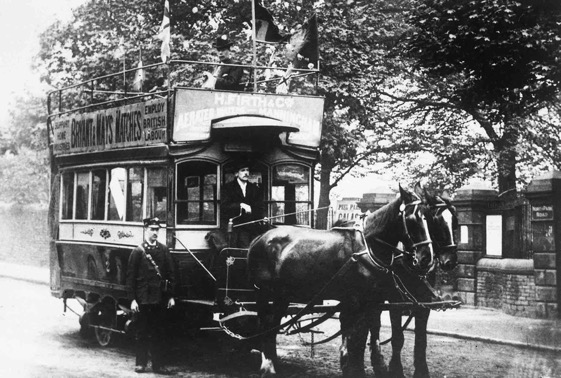
A conductor and driver pose with another Eade's Patent (Horsecar No 2) at the Victor Rd terminus — photo undated, but probably taken in the 1890s. Photo courtesy of the National Tramway Museum.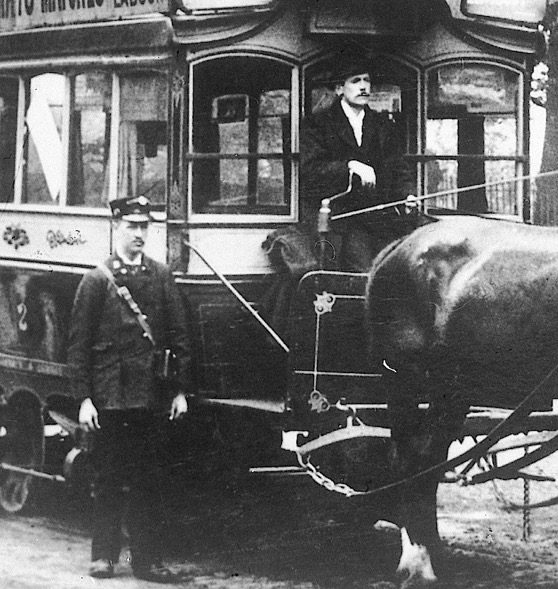
An enlargement of the above photo showing the conductor and driver The conductor's cap badge here seems to be a different pattern to that seen in previous photos, though this may just be a trick of the light. Photo courtesy of the National Tramway Museum.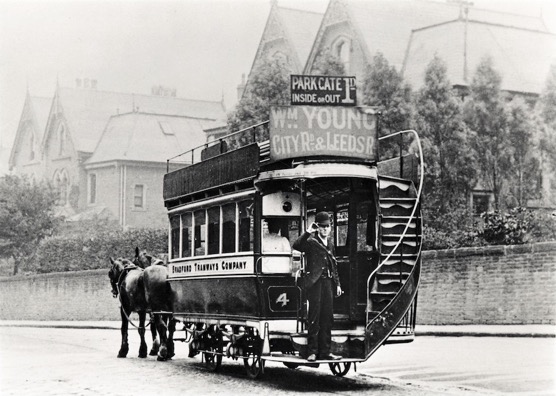
Horsecar No 4 with conductor — date and place unknown. Source unknown.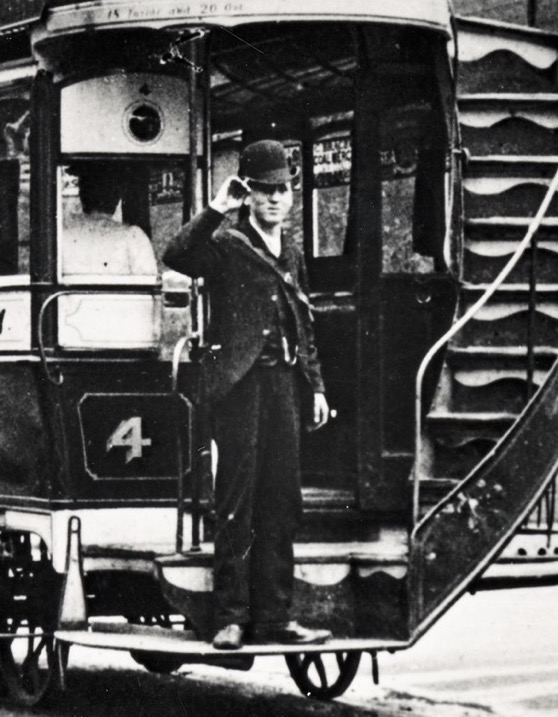
An enlargement of the above photo showing the conductor, who is wearing informal attire with a bowler hat.
Steam tram drivers and conductors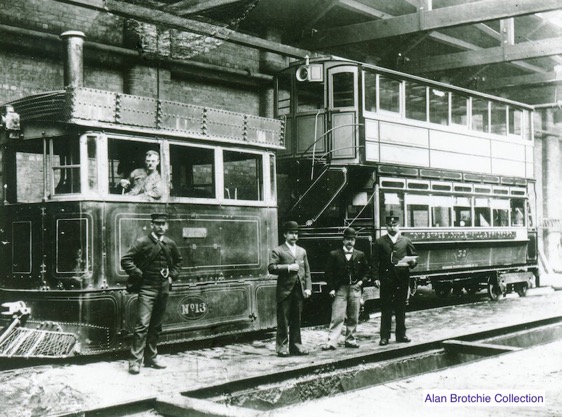
A depot shot of Steam Tram No 13 and Trailer No 32, with driver (Herbert Haigh), managers/foremen (?) and an inspector (probably) — photo undated, but given that No 13 was new in 1888, and looks to be in reasonably good condition, it was probably taken in the early-to-mid 1890s.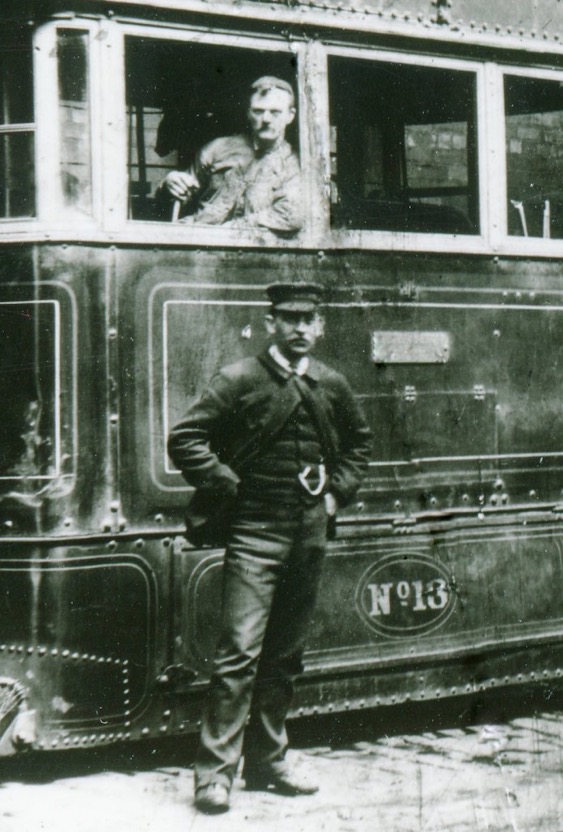
A blow-up of the above photo showing the driver, Herbert Haigh (in the cab), in light-coloured cotton jacket, and close-fitting cap.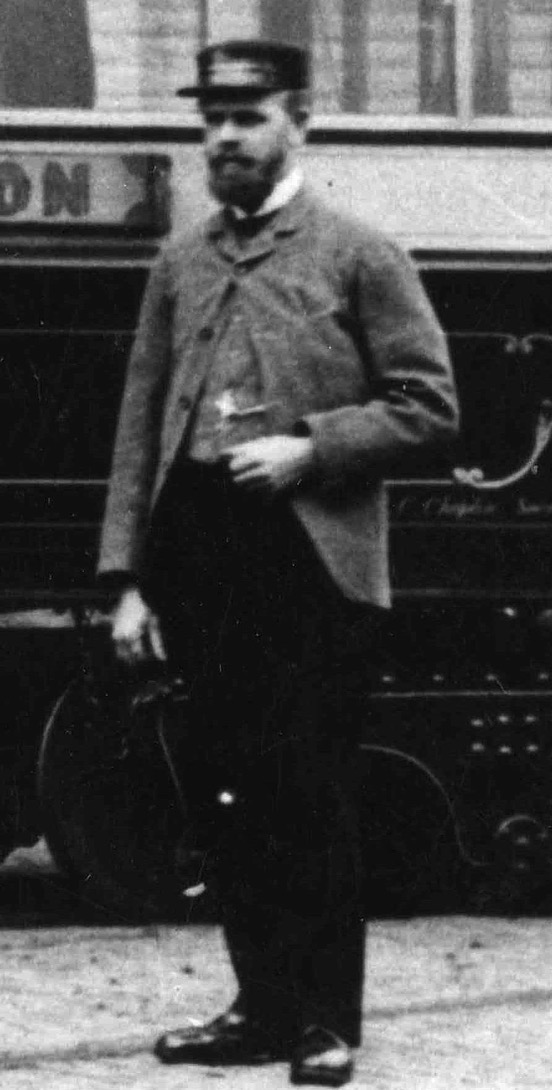
A Bradford Tramways and Omnibus Company conductor stands with Steam Trailer No 38 at Thornbury around 1890. The kepi-style cap and prominent badge are clearly seen. It is likely that the light-coloured jacket was purchased by the employee himself, rather than being a company issue. With thanks to the late Stanley King.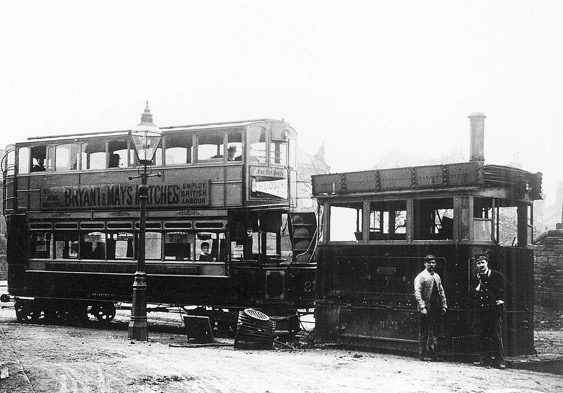
Engine No 21 (A Thomas Green & Son product of 1889) and Trailer No 27 stand in an unidentified depot yard — photo undated, but judging by the reasonably good condition of the engine, probably taken in the early 1890s. Photo courtesy of David Gladwin, with thanks to Trevor Preece.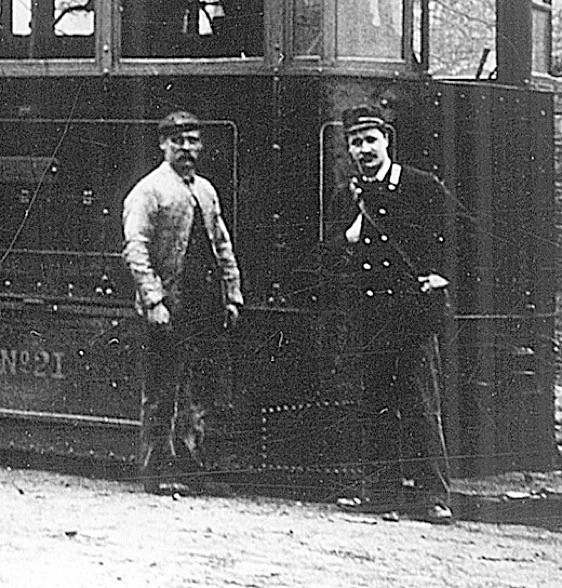
An enlargement of the above photo showing the driver and conductor, the latter wearing a company-issued jacket with reflective (i.e., metal) buttons and a kepi-style cap.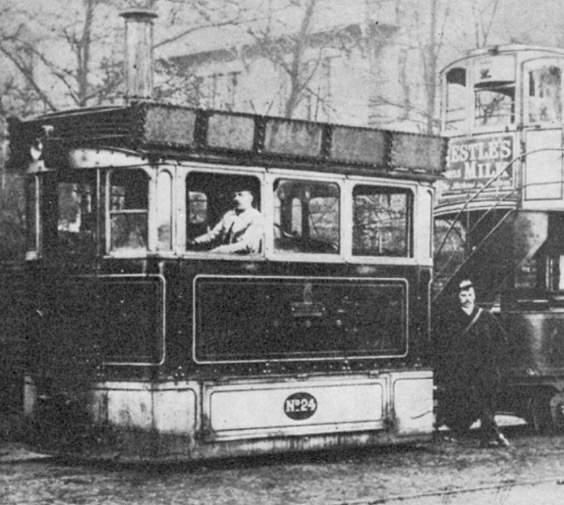
The driver of Steam Tram No 24 (a Thomas Green & Sons product) poses for the camera at the Frizinghall terminus, whilst his conductor leans nonchalantly against the vehicle — photo undated, but probably taken in the mid 1890s given that No 24 was new in 1889. Photo courtesy of the Tramways and Light Railway Society, with thanks to David Voice.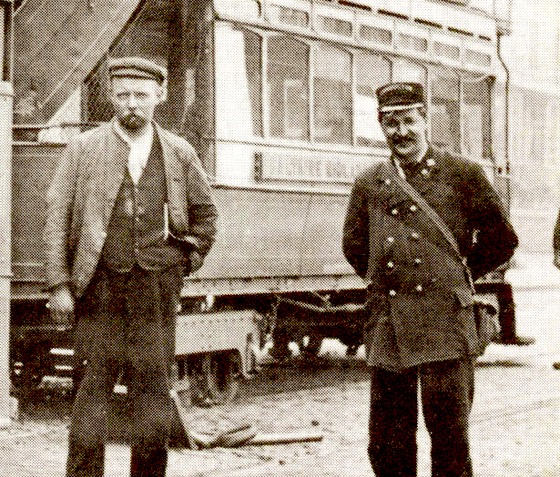
A fitter or footplate man and a conductor stand with an unidentified trailer at Saltaire — photo undated, but probably taken late on in the company's life, or potentially even in the short time the Saltaire line was steam operated by Bradford Corporation. The conductor's kepi-style cap clearly bears a large semi-circular badge, CONDUCTOR, more than likely embroidered.
Senior staff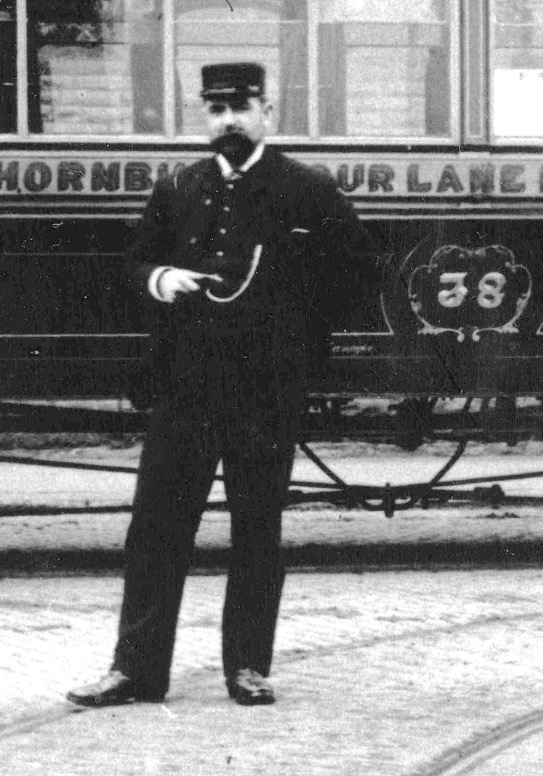
A Bradford Tramways and Omnibus Company employee, probably an inspector, taken from the same Thornbury photo as the conductor shown above. His cap may have an embroidered badge, though this is far from clear. With thanks to the late Stanley King. 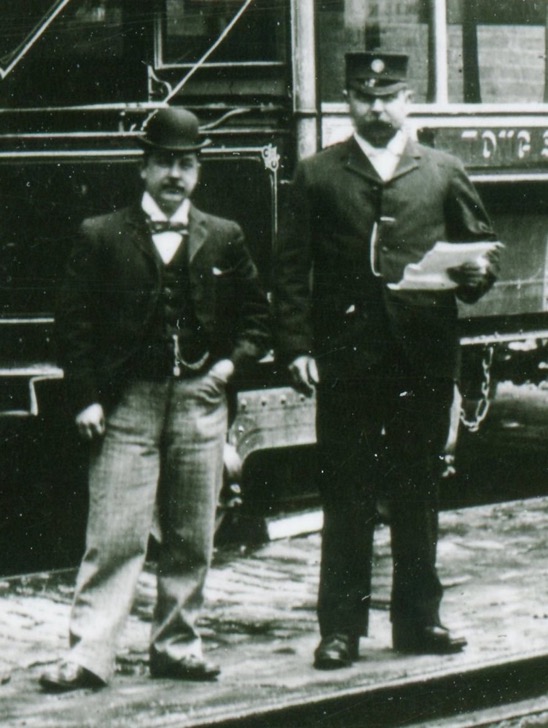
An enlargement of the depot shot above showing the inspector, who is clearly wearing a small, round cap badge.